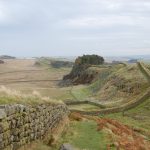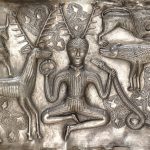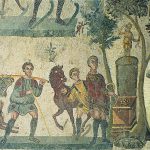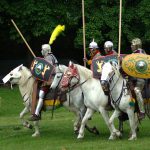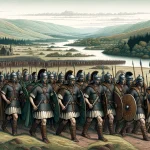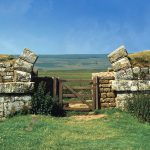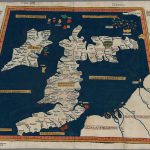Logie Durno Camp
Marching or Temporary Camp
Discovered from the air by Professor J.K. St. Joseph on 26th July 1975, the Durno camp occupies the summits of two small hills on very uneven ground between 330-440 feet (100-130m) above O.D. The river Urie flows from N-S about 500ft (c.160m) outside the SW defences, which are partially aligned with the stream. The farmstead of Westerton lies in the camp’s NW corner and the Easterton farm occupies the SE corner. The camp is roughly rectangular, but forward of the northernmost gates in the longer two sides the defences make a 30° turn to the north, so although the majority of the camp is aligned NNW-SSE, about a third is aligned roughly N-S.
Prof. St. Joseph has argued that the Durno encampment, which is easily large enough to have housed a couple of legions and a number of auxiliary regiments, represents the site of the battle of Mons Graupius narrated in the Agricola of Tacitus. This mountain itself is identified with the Hill of Bennachie, a massive granite ridge, 4½ miles (7km) long by 2 miles (3km) wide, whose highest peak rises to a height of 1,733 feet (528m) and lies to the immediate west of the Durno camp across the River Urie.
Accordingly he [Agricola] sent forward the fleet to make descents on various places, and to spread a general and vague panic; and then, with his army in light marching order, and strengthened by the best of the British soldiers … he advanced to Mons Graupius, of which the enemy was already in occupation.” (Cornelius Tacitus Agricola XXIX.ii)
References for Durno Camp
- The Camp at Durno, Aberdeenshire, and the site of Mons Graupius by J.K. St. Joseph in Britannia IX (1978) pp.271-287;
- Air Reconnaissance in Britain, 1973-76 by J.K. St. Joseph in J.R.S. lxvii (1977) pp.141/2 & fig.10;
- Agricola by Cornelius Tacitus, translated by M. Hutton (Loeb, Harvard, 1914, revised 1970).
Map References for Durno Camp
NGRef: NJ699272 OSMap: LR38
Roman Roads near Durno Camp
None identified
Sites near Logie Durno Camp
- Ythan Wells Temporary Camp 1 (12 km)
Marching or Temporary Camp - Ythan Wells Temporary Camp 2 (Glenmailen) (12 km)
Marching or Temporary Camp - Kintore Temporary Camp 2 (13 km)
Marching or Temporary Camp - Deer's Den, Kintore Temporary Camp 1 (14 km)
Marching or Temporary Camp - Normandyke Marching Camp (31 km)
Marching or Temporary Camp - Muiryfold Temporary Camp (32 km)
Marching or Temporary Camp - Devana (Aberdeen) (33 km)
Possible Roman Fort - Auchinhove Camp (34 km)
Marching or Temporary Camp - Boyndie Camp (36 km)
Marching or Temporary Camp - Bellie Camp (48 km)
Marching or Temporary Camp
